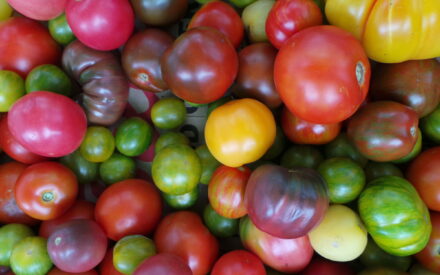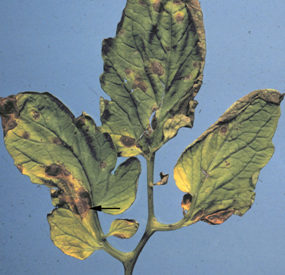
What is blossom end rot?
Blossom end rot is a physiological disorder of tomato in which the tissue of the blossom end of the fruit (the portion of the fruit opposite the stem) breaks down and rots, thus reducing yield. Pepper, eggplant and vine crop (e.g., cucumber, pumpkin, squash, watermelon) fruits can also be affected.
What does blossom end rot look like?
Blossom end rot often occurs on the first fruits formed on plants. Initially, water-soaked spots (resembling small bruises) appear, most often on the bottoms of fruits. On peppers these spots can resemble sunscald and can form on the sides of the fruits near the blossom end. Spots enlarge, becoming dark brown to black, sunken and leathery. Half the fruit may eventually be affected. Sometimes, when a fruit is cut, the exterior will be sound, but the interior will be discolored and shrunken. Often, bacteria and fungi invade the discolored areas, leading to further tissue decay.
What causes blossom end rot?
Blossom end rot is caused by a lack of calcium in the fruit. This lack of calcium may be due to low calcium levels in the soil. More often however, there is plenty of calcium in the soil, but its availability for uptake and transport to fruits is impaired. Drought stress, alternating soil moisture extremes, and damage to a plant’s roots all can inhibit calcium uptake, as can waterlogged or cold soils, and high concentrations of ammonium (NH4+), potassium (K+), and magnesium (Mg++) in soil. Movement of calcium within plants depends on active transpiration (i.e., loss of water through above-ground plant parts). Because leaves transpire more than fruits, calcium moves more easily into leaves where it remains. Calcium is not later redistributed from leaves to fruits. This preferential distribution of calcium to leaves can be made worse by over-fertilizing with nitrogen which promotes excessive production of leaves. In addition, high relative humidity OR low relative humidity in combination with hot, windy weather can limit transpiration, thus preventing calcium from reaching fruits.
How can I control blossom end rot?
Avoid conditions where there is too much or too little water. Water evenly and mulch the soil to retain moisture during dry periods. Avoid practices that would damage roots (e.g., cultivating too near plants thereby cutting roots). Use nitrate (NO3–) rather than ammonium (NH4+) forms of nitrogen fertilizer. DO NOT over-fertilize. Have your soil tested periodically to determine if there is sufficient calcium in the soil. If not, add calcium (e.g., bonemeal or lime). Check the soil pH on a regular basis, particularly if you use lime as a calcium source. Use of lime tends to increase soil pH. A pH of about 6.5 is ideal for growing most vegetables. Finally, grow vegetable varieties/cultivars that are tolerant of calcium deficiencies and less likely to show blossom end rot symptoms.
For more information on blossom end rot:
Contact the University of Wisconsin Plant Disease Diagnostics Clinic (PDDC) at (608) 262-2863 or pddc@wisc.edu.
Authors: Ann Joy and Brian Hudelson, UW-Madison Plant Pathology
Last Revised: 02/28/2024
D-number: D0022
References to pesticide products in this publication are for your convenience and are not an endorsement or criticism of one product over similar products. You are responsible for using pesticides according to the manufacturer’s current label directions. Follow directions exactly to protect the environment and people from pesticide exposure. Failure to do so violates the law.
Thanks to Karen Delahaut, Kristin Gies, and Barb Larson for reviewing this document.
A complete inventory of UW Plant Disease Facts is available at the University of Wisconsin-Madison Plant Disease Diagnostics Clinic website: https://pddc.wisc.edu.
Send a Plant Sample for Analysis
Be cautious when self-diagnosing plant health issues. Very few diseases can accurately be diagnosed by eye.
Contact the UW Plant Disease Diagnostics Clinic (PDDC), and for a small fee, clinic staff can examine a plant, determine the cause of the disease/disorder, and provide advice on how to control or prevent the issue.
Download Article





 Home-Grown Tomatoes for Wisconsin
Home-Grown Tomatoes for Wisconsin Black Walnut Toxicity
Black Walnut Toxicity Early Blight
Early Blight Tomato Disorder: Physiological Fruit Problems
Tomato Disorder: Physiological Fruit Problems


